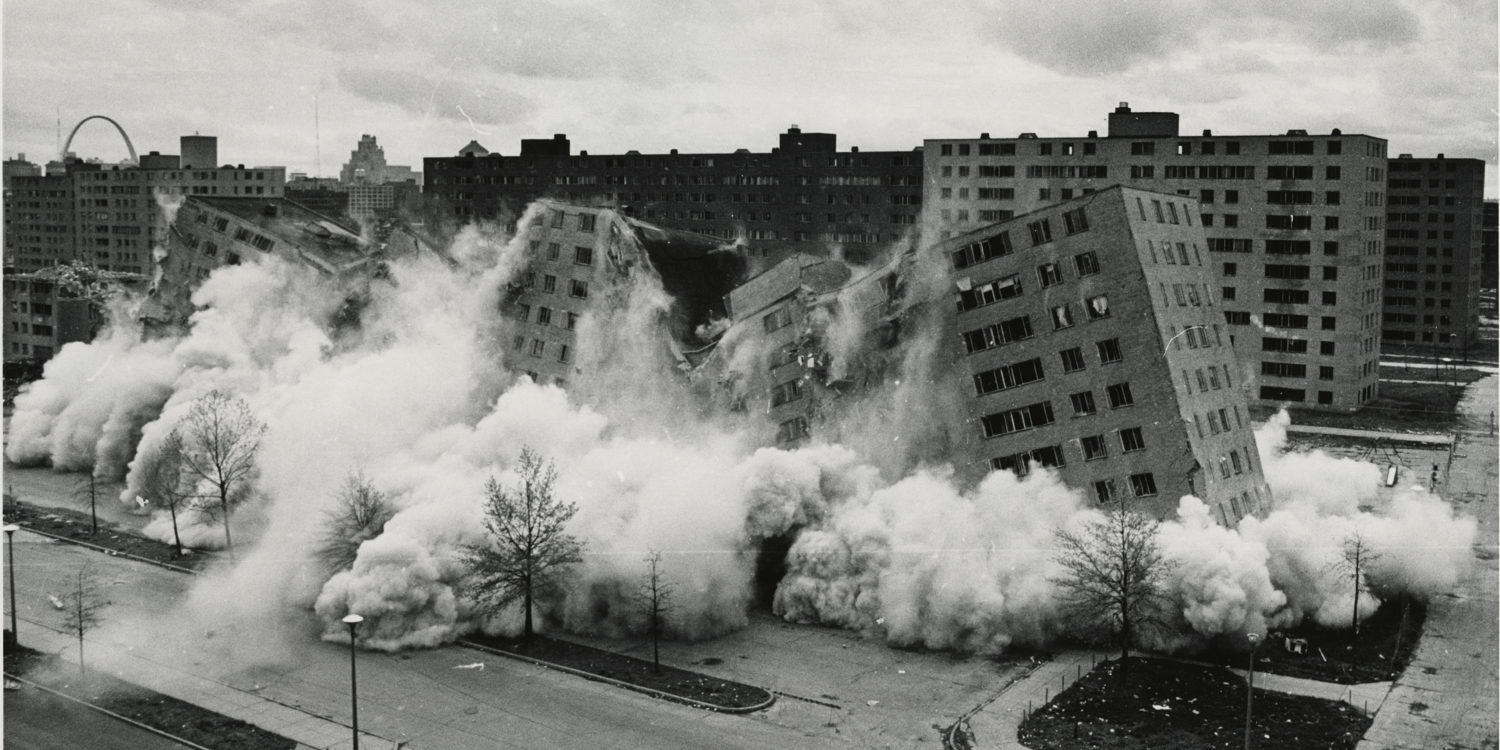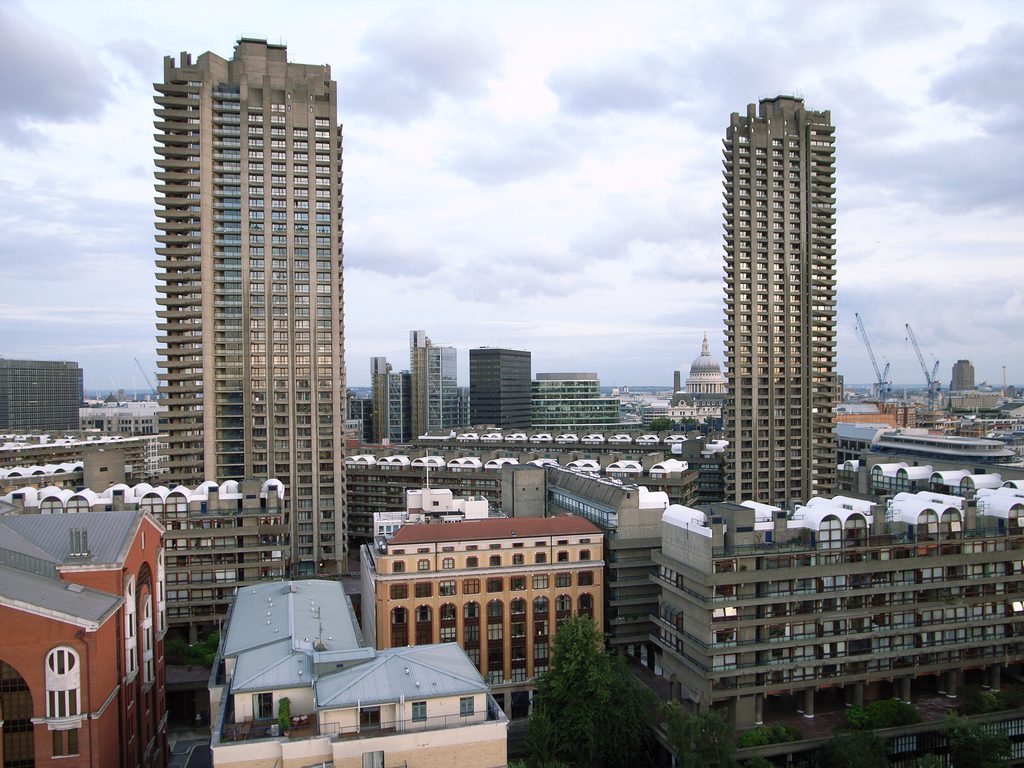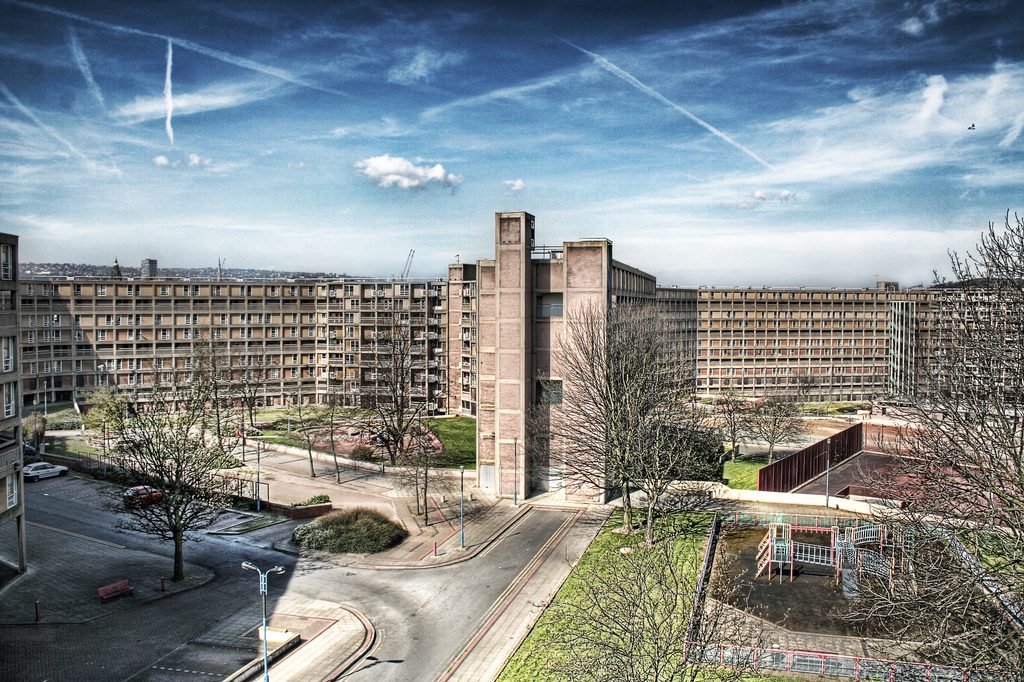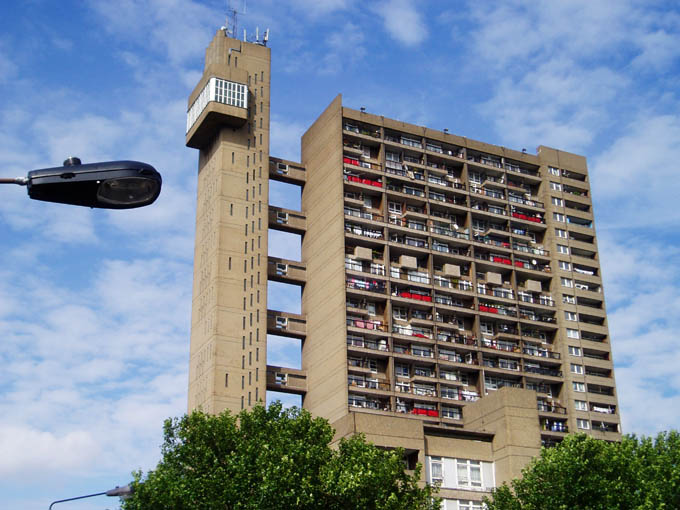Thanks to Charles Jencks, the demolition of Pruitt-Igoe is regularly cited as the moment when the modernist dream ended. The blame for this failure is habitually placed on the doorstep of the architects and planners; however, factors other than the architecture were often behind the social problems experienced by residents of mass-social housing. Why is it then that you rarely hear architects defend the architecture?
On the evening of June 13, I attended Failed Architecture’s (FA) final gathering of the year. I enjoyed the individual speakers and the panel discussion that followed; however, it was when the first two speakers illustrated their talks on dystopian and failed architecture with the same seminal image of Pruitt-Igoe’s demolition that a number of questions resurfaced in my mind.
The impetus of my interest began in May this year when for one week I stayed in an apartment off the Commercial Road close to the heart of the City of London. From my apartment complex I could see Viñoly’s partially constructed 20 Fenchurch Street, Kohn, Pedersen, & Fox’s Heron Tower, and Piano’s completed Shard. Discovering that many of these new projects included a proportion of residential accommodation as well as commercial, raised the question of why living in high-rise tower blocks was so sought after for those rich enough to live in the heart of the City of London but not for those in need of social housing.
Later, visiting the Golden Lane Estate (The Barbican Centre), the location of Chamberlin, Powell & Bon’s three residential Barbican towers, I began to think again about the dichotomy between the private (wealthy) love of high-rise living and its wholehearted rejection for social housing. Why was it people were prepared to pay over £1.5 million for a one bedroom flat in Shakespeare Tower or just under half a million for a miniscule studio flat in the new Heron Tower, but despite the crisis in social housing provision, local authorities were rejecting the spatially more efficient tower blocks in favour of low rise or new terraced accommodation. Why weren’t architects arguing the case for high-rise social housing? Because these thoughts re-surfaced after reference to Yamaraki’s Pruitt-Igoe, I thought this would be a good starting point to find possible answers.
A public housing development commissioned by the St. Louis Housing Authority, anyone with an interest in architecture or urban planning knows the name Pruitt-Igoe. Opened in 1956, by 1972 it was so crime ridden, vandalised and neglected that the decision was taken to demolish a number of its blocks. March 16, 1972, the date of the first demolition, has now become mythologised as the point at which the modernist dream finally succumbed to the realities of the world. However, as Chad Freidrichs’ documentary The Pruitt-Igoe Myth: An Urban History so clearly shows, new residents in 1956 described the project as ‘an oasis in the desert’ and for many it was like ‘living in a big hotel resort.’ There were no complaints about the architecture. So what were the factors behind the projects trajectory from an oasis to a dystopian nightmare?
The reasons were manifold, far too complex to deal with in full here, but at a simple level, St. Louis was a declining city well before residents moved into Pruitt-Igoe. The majority of residents came from the Afro-American community and were disproportionately affected by the city’s rising unemployment. Unemployed residents could not pay rent and therefore rental income reduced. At the same time, the St. Louis Housing Authority had, for ideological reasons, decided that the entire maintenance programme was to be funded by rental income alone. This combination of events ensured there was little or no money available for essential maintenance work. The infrastructure deteriorated and in a spiral of decline, crime rose, vandalism increased, leading to greater deterioration of the fabric: a true vicious circle.
A somewhat similar story can be told of Park Hill in Sheffield. Lynn and Smith’s design opened in 1961 to replace the city’s Victorian slum terraces. When the first residents took up occupancy, it was hugely popular. Like Pruitt-Igoe residents, Park Hill’s new occupants loved the architecture, the ‘streets in the sky’ and the deck access, often remarking about its great community spirit. However, over the course of a number of years, Park Hill deteriorated. Issues over maintenance abound at a time in the 1970s and 1980s when the local authority owner was suffering from financial restrictions. However, in 1998, English Heritage decided to award the site a Grade II* listing as an acknowledgement of its architectural significance. Urban Splash took on the role of bringing the site back from the edge and has succeeded to the point where, as of June 2013, all rental accommodation has been let and very few properties are available to purchase. A corresponding story can be told of Goldfinger’s Trellick Tower in London’s North Kensington. It also had a reputation for crime and drugs, but like Park Hill, it’s now Grade II* listed and is a highly sort after residential address.
Yet, apart from some renovations and some much needed maintenance, Park Hill and the Trellick Tower are architecturally the same now as they were when first constructed and when they were locations of social deprivation in the 1970s and 1980s. The difference today is that they both have become aspirational places to live. The towers on the Golden Lane Estate on the other hand have always been aspirational. They have never suffered the social blight affecting similar structures used for social housing even though they were designed within the same ideological framework. You do not hear calls by Barbican residents that they want to be rehoused; that there is no community; that the architecture is unattractive or failed. As a piece of counter-factual history, I often think about how these towers would be considered if they had been built in a poorer area of Britain and used as housing for those displaced by slum-clearance? I’m not sure they would still be standing.
If it’s not the architecture then what was the problem? One issue in Britain is the change from a mixed demographic within social housing tenancies. British social housing in the decades immediately following the end of the Second World War was open and accessible to large sectors of the community. I grew up on a 1960s outer-London housing estate consisting of three tower blocks of eleven stories, low rise maisonettes, detached, semi-detached and terraced housing. The mixed demographics included those employed in unskilled, blue and white collar labour, some families were on social benefit, many residents had young families, and there were a number of retired people. This all changed when the Conservative Government, headed my Margaret Thatcher, introduced the 1980 Housing Act which gave the right to social tenants to purchase their homes. To be fair, London’s social tenants had been given the right to buy their properties earlier when the Greater London Council was under Labour control, but it wasn’t until 1980 that this was extended nationally. Local authorities housing stock was often sold with a large discount calculated to reflect the amount of rent paid previously, sometimes up to 50% of market value. However, local authorities were not allowed to use the revenue gained from these sales to replace the lost housing stock and therefore the amount available to new tenants was drastically reduced.
Social housing was ever more rationed and allocated through a strict points system based on applicants’ circumstance. The fewer properties available the higher the number of points required for allocation. Unfortunately this ensured that rather than maintaining a mixed demographic, social housing came to be dominated by sections of society who met the criteria because they suffered from an array of society’s ills. Social housing, especially tower blocks (fewer tenants wanted to purchase their apartments than those who lived in low rise accommodation), became a dumping ground for society’s less-fortunate and often less able. Clearly, a concentration of this sort was bound to accentuate residents existing social issues.
Another possible reason was the obstacles put in the path of architects and planners when attempting to implement their designs in full. As early as 1953, J.M.Richards wrote an article for the Architectural Review titled ‘The Failure of New Towns’. He believed the new town project had failed on three main counts: socially, economically, and architecturally. The greatest disappointment for Richards was, unsurprisingly, the architecture. He noted that although the new town offered the biggest architectural opportunity in post-war Britain, many lacked an urban heart and they often looked more like the Garden Cities of the 1920s rather than the modern designs they were meant to be. A point noted in a response to Richards’ article by Lionel Brett (then Chief Architect for Hatfield). Brett believed the problem was the new towns lack of variety: they were too ‘monotonous’. Placing the blame on too many people being employed to look over each other, Brett believed they were stultifying ‘the ingenuity, integrity and local knowledge of the architect on the spot.’ Underlying all these issues was the simple and straight-forward lack of cash. If a material was cheaper to use, regardless of other properties, then it was hard to argue not to use it everywhere.
According to Brett, this was the prime cause of the monotony not the plans of the architects. Flynn confirms this in her 2012 article the ‘‘City of our Dreams’ the Political Realities of Rebuilding Britain’s Blitzed Cities, 1945-54.’ Flynn argues that the historiographical tradition of creating a dichotomy between the immediate post-war rhetoric of hope and potential for the future, based on CIAM influenced plans for reconstruction, versus the vocabulary of post-war planning failures, the loss of urban/rural beauty, and the subsequent blame heaped on architects and planners in the 1970s and 1980s ignores the realities of the time. As Brett recognised in 1953, it was a period that suffered from a shortage of labour, materials (export was deemed more important than inward investment) and the devaluation of Sterling all ensured plans were rarely completed to original specification or maintained adequately after their realisation. The alleged failure of new towns cited by Richards and Brett reflected aesthetic concerns not the necessarily the subsequent social ills, these came later. Yet, many of the issues they raised, monotony for example, have been cited as the causes of later social problems associated with mass-housing projects.
What I am saying here with these examples is pretty simple: it’s not the architecture that failed. If it was, then the Barbican Towers would be deemed failures. Park Hill and Trellick Tower would still be considered design catastrophes. The cause of Pruitt-Igoe’s descent into its nightmare and final destruction was the failure in the social support and a failure to maintain the buildings fabric not the concept of Yamaraki’s design. Park Hill and the Trellick Tower were on essentially the same trajectory, heading for demolition, but increased consideration of maintenance and widening the demographic mix helped bring them back from the brink. Just as the three towers of the Barbican have always been, Park Hill and Trellick are now aspirational locations. Yet, as we heard at the FA meeting, towers such as those at Lenton in Nottingham are still being demolished, blamed for the social problems experienced by their residents. Why aren’t architects standing up and shouting in their defence that it was not wholly the fault of the architecture?
Have architects been cowed by their professions alleged mistakes of the 1960s and 1970s? During the panel discussion at the same FA session, Indira van’t Klooster, A10‘s editor in chief, suggested architects, in particular small practises, were no longer ideological. Why? In terms of ideology, it could simply be that it affects cash flow. Can architects today afford to say no to a commission in China because they disagree with that country’s system of government, or refuse a contract to design a corporate HQ in a European city simply because the company is suspected of malpractice in the Nigerian oil fields? Of course, it could be that the last time architects raised their heads above the parapet of ideological invisibility in any significant manner was in the middle to second half of the twentieth century. The acolytes of CIAM believed building of the right kind could transform lives and make us happier people. Ideas that were spread across the globe by architects/planners who set themselves up as the expert found willing audiences in governments who wanted to clear unsanitary slums. Consequently, in 1972 when the demolition of Pruitt-Igoe marked the end of the modernist project, the architect/planner took the blame for all the associated social miseries linked to mass-housing projects. Has the profession actually rehabilitated itself from this low point? Should architects today feel safe not only promoting their designs within an ideological stance but also to feel free to defend past approaches? Are they able to stand up and argue that architecture was not the primary cause of the social ills associated with mass-housing projects? Or would they want to anyway?
If factors other than the architecture were to blame for the social ills associated with mass-housing projects, a point recognised to some extent as early as 1953 by Richards and Brett and confirmed again by Flynn, why aren’t architects standing up and arguing this case. I would be happy to be proved wrong in this and be shown they do. Is it because if architects suggest it was not the architecture’s fault and that outside factors caused the social problems, they would in fact be arguing that these issues would have occurred regardless of the architectural ethos adopted. Architecture, in this argument, is therefore a semi-redundant factor, and hence arguably, would no longer be deemed a significant part of the solution. If this is the case, then architects need the idea of failed architecture and failed design concepts. It is central to the profession because it opens the door to offering architectural solutions to supposedly architectural problems, even when architecture is not necessarily the causal or determining factor of those problems.
This is not an abstract argument. If architects ‘bite the bullet’ and begin to rehabilitate the idea of high-rise architecture as accommodation not just for the wealthy but also for mass-social housing as a counter to Europe’s increasingly desperate housing shortages, they will also have to acknowledge that architecture is only a minor factor in ensuring social cohesion. They’ll need to be humble enough to argue that without wider support from society, the same problems that affected mass-housing projects from the 1970s up until today will simply be exacerbated.
Gary W. Davies asserts his right to be the identified as the author of this work. The text has been produced under a Creative Commons license, by which you are free to share (please do) provided you attribute it to Gary W. Davies. Details are outlined in full detail here.



